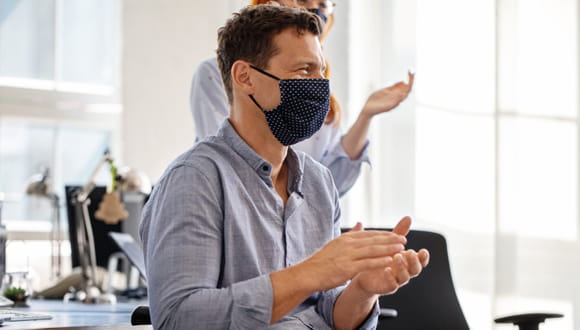Should You Still Wear A Mask Even If Everyone Around You Isn't?
April 20, 2022 - Katie McCallumIt's true that masks work best when everyone in a space is wearing one. It's also true that they're most critical in indoor places, especially crowded, public ones.
But, as mask restrictions continue to ease — most notably of late in airports and on airplanes — you may find yourself being one of the few people wearing a mask at times.
Now more than ever, there's a long-standing question you need answered: Does my mask really protect me even if no one else is wearing one?
Do masks protect the wearer from getting COVID-19?
Good news: Yes! Masks provide protection to both other people and the wearer. Several studies have demonstrated the dual function, and the CDC has released a scientific brief on the topic.
This means that, if you're in a public space where no one else is wearing a mask, you'll still benefit from wearing one. So keep it on!
Masks filter the fine droplets in the air that you may have otherwise breathed in, infectious ones included. It's important to note, though, that mask material and mask fit are two of the most important factors that determine how well a mask filters these droplets.
Medical grade masks typically incorporate at least three layers (referred to as 3-ply) of a non-woven fabric called polypropylene, a highly efficient filtering medium. In cloth masks, the more layers and higher the thread count, the better they will be at filtering air before you breathe it.
Fit also matters since effective filtration depends on the air you breathe first passing through the mask rather than seeping in — unfiltered — via gaps around the edges. This is why tactics that improve the fit of a mask, such as knotting-and-tucking the ear loops and double-masking, can help improve its filtration. A Feb. 2021 study showed that a well-fitted mask using such tactics can reduce exposure to simulated cough particles by 83%.
Ultimately, you're most protected if you and everyone around you wears a mask — because this reduces the amount of infectious droplets circulating and, therefore, the amount your mask has to effectively filter.
However, there's still a benefit to wearing a mask — the right mask — even when everyone else isn't.
What's the best mask to wear to protect yourself from COVID-19?
It probably comes as no surprise, but not all masks are created equal.
There are two main types of masks:
- Reusable cloth masks
- Disposable masks
In simplest terms, the "best mask" is one that filters effectively, covers your nose and mouth and fits snugly, leaving no gaps around the edge of your face or at the bridge or your nose.
Reusable cloth masks have gotten a bad rap, but that doesn't mean they aren't handy to have in your mask arsenal. In choosing a cloth mask, opt for one that is constructed with at least two (preferably, three to four) layers of a tightly-woven fabric and that underwent testing to prove its effectiveness at filtering fine particles (less than 10 microns). Definitely take some time to research the manufacturer — testing, for instance, should have been performed by a certified lab.
Additionally, be sure to frequently wash your cloth mask. And avoid cloth masks with exhalation valves or vents, the CDC recommends.
When it comes to disposable masks, be sure to choose one with an ASTM (American Society for Testing and Materials)-rated label, which include surgical masks. There are three levels (1, 2 and 3), and the higher a disposable mask is rated, the more protection it provides.
If you like the look of a cloth mask but want the protection of a surgical mask, wear an ASTM-rated disposable mask underneath your cloth mask. Just be sure your cloth mask enhances the overall fit, sealing gaps along the edges of the surgical mask.
Lastly, masks alone aren't enough to protect you from COVID-19. To reduce your risk and prevent the spread of COVID-19, also be sure to socially distance, avoid crowds, wash your hands and avoid touching your face.


